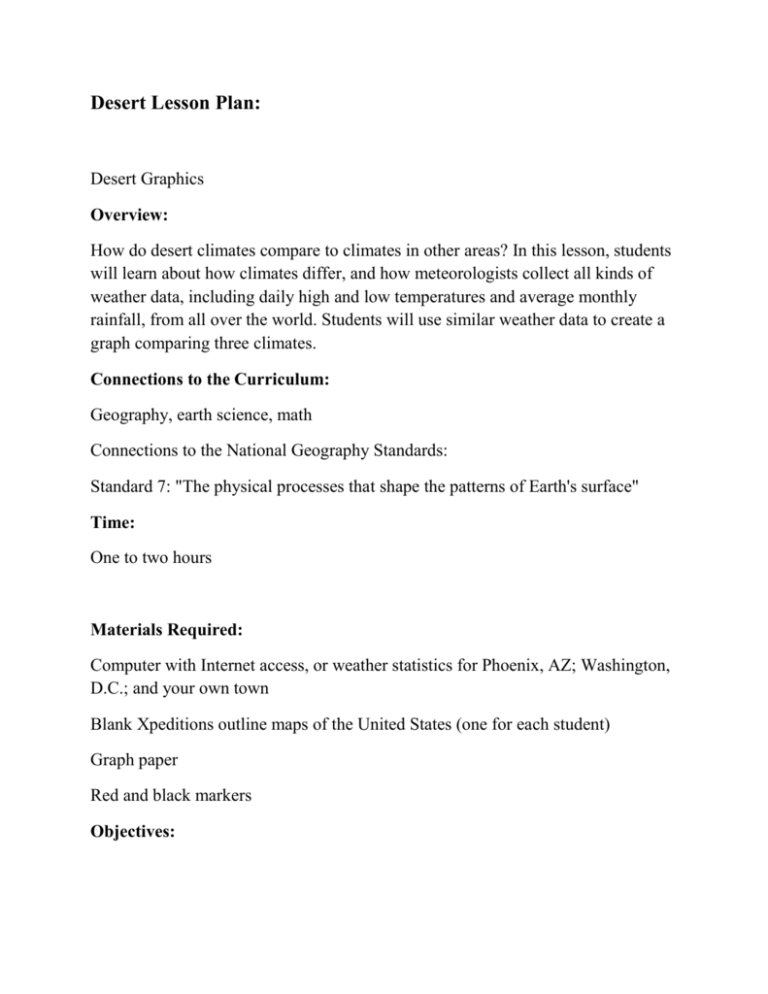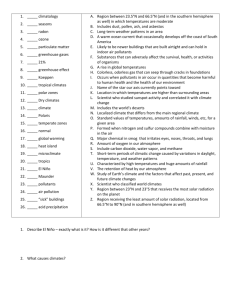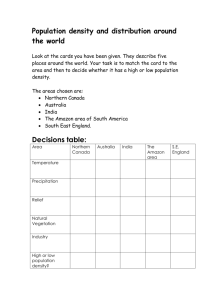Desert Lesson Plan:
advertisement

Desert Lesson Plan: Desert Graphics Overview: How do desert climates compare to climates in other areas? In this lesson, students will learn about how climates differ, and how meteorologists collect all kinds of weather data, including daily high and low temperatures and average monthly rainfall, from all over the world. Students will use similar weather data to create a graph comparing three climates. Connections to the Curriculum: Geography, earth science, math Connections to the National Geography Standards: Standard 7: "The physical processes that shape the patterns of Earth's surface" Time: One to two hours Materials Required: Computer with Internet access, or weather statistics for Phoenix, AZ; Washington, D.C.; and your own town Blank Xpeditions outline maps of the United States (one for each student) Graph paper Red and black markers Objectives: Students will compare average daily temperatures and rainfall of a desert region and a coastal region; plot data on line and bar graphs; analyze their graphs; and add data from their own hometown to the graphs. Geographic Skills: Asking Geographic Questions Acquiring Geographic Information Answering Geographic Questions Analyzing Geographic Information Suggested Procedure Opening: Ask students if they have experienced a desert climate and explain what it was like. (If they haven't been to a desert climate, what do they imagine it would be like?) What kinds of animals and plants grow in the desert? Why? Development: Have students go to the Weather Channel online and look at the weather statistics for Phoenix, AZ and Washington, D.C. [Note: Pass out copies of the statistics if you don't have enough computers for students to look them up on their own.] Ask students to look at the data on the average daily high temperatures chart. Ask if someone can explain what these temperatures mean. If necessary, explain that thermometers record the highest temperature of each day, and that these daily high temperatures are then averaged together to find the average monthly temperatures. Ask students to choose a month or two from the average daily high temperatures chart and calculate the monthly average. They can check their answers on the monthly averages chart. Have students note the rainfall data on the chart. The rainfall data for each month was averaged together to get these figures in the same way that students have just averaged the temperatures. Have students mark Phoenix, Arizona; Washington, D.C.; and their own hometown on their outline maps of the United States. Ask the students what type of climate each area has. They should note that Phoenix is located in the Sonoran Desert and has a hot desert climate. Washington, D.C., is on the East Coast and has what is called a humid continental climate. What is the climate in their hometown? Ask students to form pairs, but show their work on their own maps. Working together, they will create line and bar graphs showing temperature and rainfall differences between Phoenix and Washington, D.C. First, ask students to plot average monthly temperature data on a line graph, with the horizontal (x) axis showing the names of the months, and the vertical (y) axis showing the temperature in degrees Fahrenheit, in ten degree increments. Have them plot points in red for Phoenix and black for Washington, and connect the lines once they have finished. Next, have students make two separate bar graphs, one showing the average monthly rainfall for Phoenix and the other the average monthly rainfall for Washington, D.C. The horizontal (x) axis should again show the names of the months, and the vertical (y) axis should show the rainfall amounts in inches, using 0.5 inch increments. [Note: Calculations in Celsius and centimeters could also be used for each graph in order to help students practice conversions.] Closing: After students have completed their graphs, have them answer the following questions, either on paper or in a class discussion: In which months was there the greatest difference in the average daily high temperatures between Washington, D.C. and Phoenix? Which area had the higher average temperature in June? In how many months of the year did Washington, D.C., have more than twice the amount of rain that Phoenix had? How do graphs help make data easier to understand? Why is it important to keep records that show the average temperatures and the average amount of rainfall in an area? Suggested Student Assessment: Have students research average monthly high temperatures and monthly rainfall for their own town. Have each student add a line to his or her line graph showing the average monthly high temperatures in their area, and create a third rainfall graph showing the average monthly rainfall in their area. Ask students to write a paragraph below each new graph explaining how their area compares to Phoenix and Washington, D.C. For example, how do they think differences in temperature and rainfall reflect what goes on in their area in terms of agriculture or tourism? Extending the Lesson: Compare desert climates to other types of climates, such as polar, rain forest, alpine, and grassland climates. Pick cities in each type of climate and then look up the weather data in a statistical abstract or almanac. This lesson is adapted from Ranger Rick's Naturescope® Discovering Deserts (National Wildlife Federation®).





